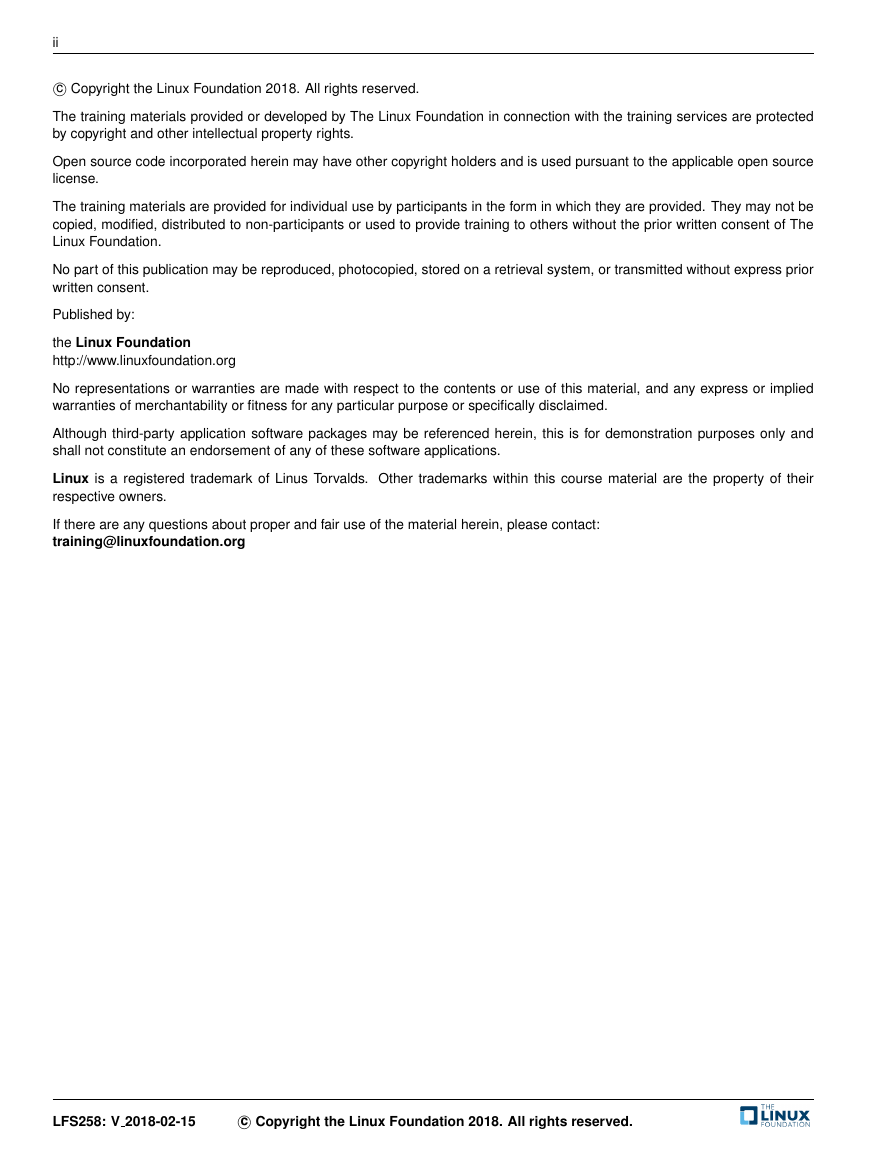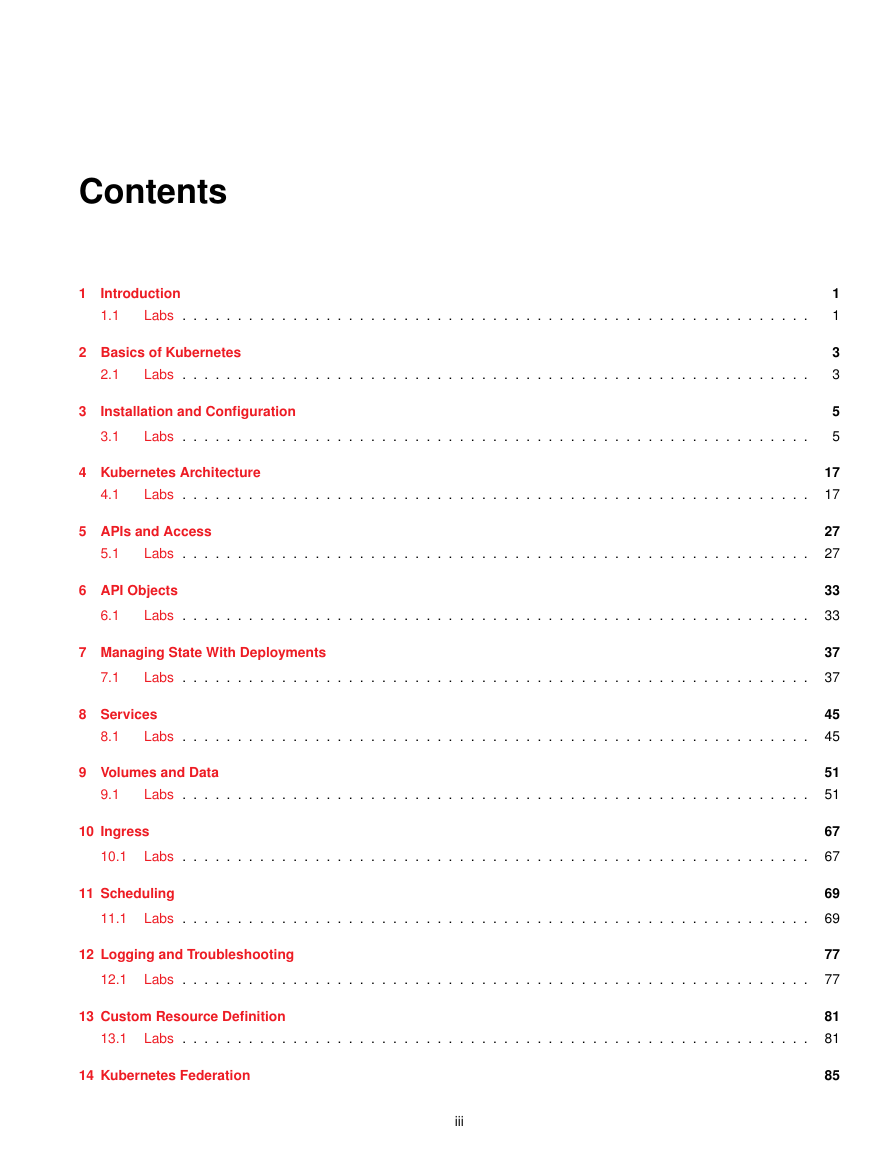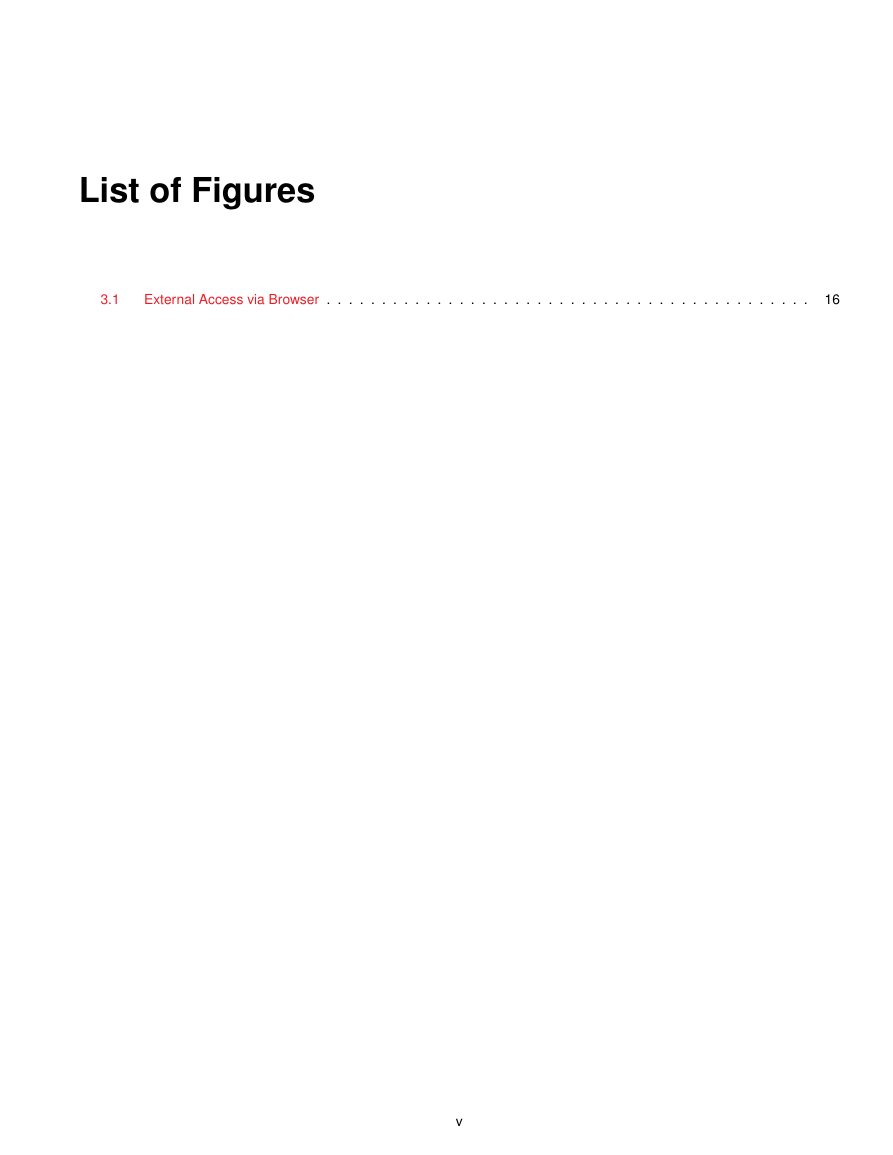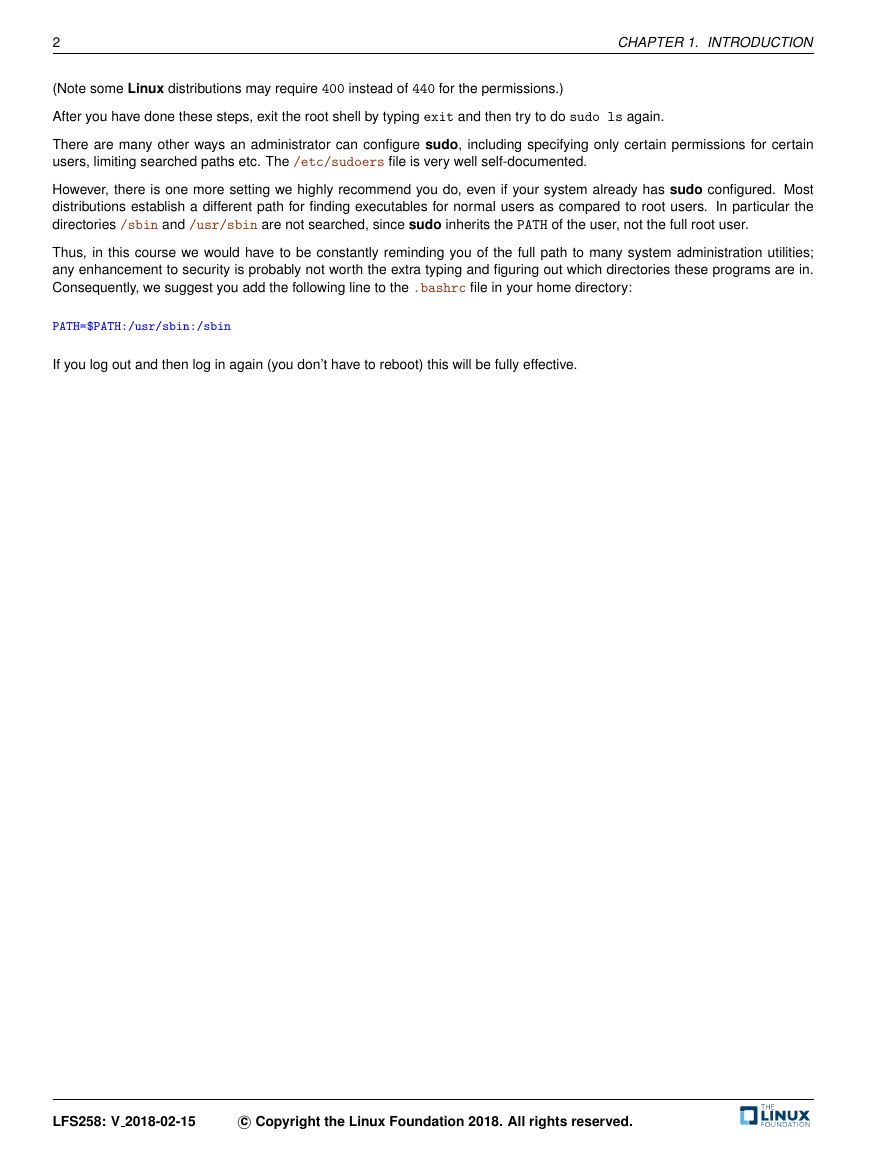LFS258: Version 2018-02-15
c Copyright the Linux Foundation 2018. All rights reserved.
LFS258KubernetesFundamentalsVersion2018-02-15�
ii
c Copyright the Linux Foundation 2018. All rights reserved.
The training materials provided or developed by The Linux Foundation in connection with the training services are protected
by copyright and other intellectual property rights.
Open source code incorporated herein may have other copyright holders and is used pursuant to the applicable open source
license.
The training materials are provided for individual use by participants in the form in which they are provided. They may not be
copied, modified, distributed to non-participants or used to provide training to others without the prior written consent of The
Linux Foundation.
No part of this publication may be reproduced, photocopied, stored on a retrieval system, or transmitted without express prior
written consent.
Published by:
the Linux Foundation
http://www.linuxfoundation.org
No representations or warranties are made with respect to the contents or use of this material, and any express or implied
warranties of merchantability or fitness for any particular purpose or specifically disclaimed.
Although third-party application software packages may be referenced herein, this is for demonstration purposes only and
shall not constitute an endorsement of any of these software applications.
Linux is a registered trademark of Linus Torvalds. Other trademarks within this course material are the property of their
respective owners.
If there are any questions about proper and fair use of the material herein, please contact:
training@linuxfoundation.org
LFS258: V 2018-02-15
c Copyright the Linux Foundation 2018. All rights reserved.
�
Contents
1 Introduction
1.1
Labs . . . . . . . . . . . . . . . . . . . . . . . . . . . . . . . . . . . . . . . . . . . . . . . . . . . . . . . . .
2 Basics of Kubernetes
2.1
Labs . . . . . . . . . . . . . . . . . . . . . . . . . . . . . . . . . . . . . . . . . . . . . . . . . . . . . . . . .
3 Installation and Configuration
3.1
Labs . . . . . . . . . . . . . . . . . . . . . . . . . . . . . . . . . . . . . . . . . . . . . . . . . . . . . . . . .
4 Kubernetes Architecture
4.1
Labs . . . . . . . . . . . . . . . . . . . . . . . . . . . . . . . . . . . . . . . . . . . . . . . . . . . . . . . . .
5 APIs and Access
5.1
Labs . . . . . . . . . . . . . . . . . . . . . . . . . . . . . . . . . . . . . . . . . . . . . . . . . . . . . . . . .
6 API Objects
6.1
Labs . . . . . . . . . . . . . . . . . . . . . . . . . . . . . . . . . . . . . . . . . . . . . . . . . . . . . . . . .
7 Managing State With Deployments
7.1
Labs . . . . . . . . . . . . . . . . . . . . . . . . . . . . . . . . . . . . . . . . . . . . . . . . . . . . . . . . .
8 Services
8.1
Labs . . . . . . . . . . . . . . . . . . . . . . . . . . . . . . . . . . . . . . . . . . . . . . . . . . . . . . . . .
9 Volumes and Data
9.1
Labs . . . . . . . . . . . . . . . . . . . . . . . . . . . . . . . . . . . . . . . . . . . . . . . . . . . . . . . . .
10 Ingress
10.1
Labs . . . . . . . . . . . . . . . . . . . . . . . . . . . . . . . . . . . . . . . . . . . . . . . . . . . . . . . . .
11 Scheduling
11.1
Labs . . . . . . . . . . . . . . . . . . . . . . . . . . . . . . . . . . . . . . . . . . . . . . . . . . . . . . . . .
12 Logging and Troubleshooting
12.1
Labs . . . . . . . . . . . . . . . . . . . . . . . . . . . . . . . . . . . . . . . . . . . . . . . . . . . . . . . . .
13 Custom Resource Definition
13.1
Labs . . . . . . . . . . . . . . . . . . . . . . . . . . . . . . . . . . . . . . . . . . . . . . . . . . . . . . . . .
14 Kubernetes Federation
iii
1
1
3
3
5
5
17
17
27
27
33
33
37
37
45
45
51
51
67
67
69
69
77
77
81
81
85
�
iv
CONTENTS
14.1
Labs . . . . . . . . . . . . . . . . . . . . . . . . . . . . . . . . . . . . . . . . . . . . . . . . . . . . . . . . .
15 Helm
15.1
Labs . . . . . . . . . . . . . . . . . . . . . . . . . . . . . . . . . . . . . . . . . . . . . . . . . . . . . . . . .
16 Security
16.1
Labs . . . . . . . . . . . . . . . . . . . . . . . . . . . . . . . . . . . . . . . . . . . . . . . . . . . . . . . . .
85
87
87
91
91
LFS258: V 2018-02-15
c Copyright the Linux Foundation 2018. All rights reserved.
�
List of Figures
3.1
External Access via Browser . . . . . . . . . . . . . . . . . . . . . . . . . . . . . . . . . . . . . . . . . . . .
16
v
�
vi
LIST OF FIGURES
LFS258: V 2018-02-15
c Copyright the Linux Foundation 2018. All rights reserved.
�
Chapter 1
Introduction
1.1 Labs
Exercise 1.1: Configuring the System for sudo
It is very dangerous to run a root shell unless absolutely necessary: a single typo or other mistake can cause serious (even
fatal) damage.
Thus, the sensible procedure is to configure things such that single commands may be run with superuser privilege, by using
the sudo mechanism. With sudo the user only needs to know their own password and never needs to know the root password.
If you are using a distribution such as Ubuntu, you may not need to do this lab to get sudo configured properly for the course.
However, you should still make sure you understand the procedure.
To check if your system is already configured to let the user account you are using run sudo, just do a simple command like:
$ sudo ls
You should be prompted for your user password and then the command should execute. If instead, you get an error message
you need to execute the following procedure.
Launch a root shell by typing su and then giving the root password, not your user password.
On all recent Linux distributions you should navigate to the /etc/sudoers.d subdirectory and create a file, usually with the
name of the user to whom root wishes to grant sudo access. However, this convention is not actually necessary as sudo will
scan all files in this directory as needed. The file can simply contain:
student ALL=(ALL)
ALL
if the user is student.
An older practice (which certainly still works) is to add such a line at the end of the file /etc/sudoers. It is best to do so using
the visudo program, which is careful about making sure you use the right syntax in your edit.
You probably also need to set proper permissions on the file by typing:
$ chmod 440 /etc/sudoers.d/student
1
�
2
CHAPTER 1.
INTRODUCTION
(Note some Linux distributions may require 400 instead of 440 for the permissions.)
After you have done these steps, exit the root shell by typing exit and then try to do sudo ls again.
There are many other ways an administrator can configure sudo, including specifying only certain permissions for certain
users, limiting searched paths etc. The /etc/sudoers file is very well self-documented.
However, there is one more setting we highly recommend you do, even if your system already has sudo configured. Most
distributions establish a different path for finding executables for normal users as compared to root users.
In particular the
directories /sbin and /usr/sbin are not searched, since sudo inherits the PATH of the user, not the full root user.
Thus, in this course we would have to be constantly reminding you of the full path to many system administration utilities;
any enhancement to security is probably not worth the extra typing and figuring out which directories these programs are in.
Consequently, we suggest you add the following line to the .bashrc file in your home directory:
PATH=$PATH:/usr/sbin:/sbin
If you log out and then log in again (you don’t have to reboot) this will be fully effective.
LFS258: V 2018-02-15
c Copyright the Linux Foundation 2018. All rights reserved.
�
















 2023年江西萍乡中考道德与法治真题及答案.doc
2023年江西萍乡中考道德与法治真题及答案.doc 2012年重庆南川中考生物真题及答案.doc
2012年重庆南川中考生物真题及答案.doc 2013年江西师范大学地理学综合及文艺理论基础考研真题.doc
2013年江西师范大学地理学综合及文艺理论基础考研真题.doc 2020年四川甘孜小升初语文真题及答案I卷.doc
2020年四川甘孜小升初语文真题及答案I卷.doc 2020年注册岩土工程师专业基础考试真题及答案.doc
2020年注册岩土工程师专业基础考试真题及答案.doc 2023-2024学年福建省厦门市九年级上学期数学月考试题及答案.doc
2023-2024学年福建省厦门市九年级上学期数学月考试题及答案.doc 2021-2022学年辽宁省沈阳市大东区九年级上学期语文期末试题及答案.doc
2021-2022学年辽宁省沈阳市大东区九年级上学期语文期末试题及答案.doc 2022-2023学年北京东城区初三第一学期物理期末试卷及答案.doc
2022-2023学年北京东城区初三第一学期物理期末试卷及答案.doc 2018上半年江西教师资格初中地理学科知识与教学能力真题及答案.doc
2018上半年江西教师资格初中地理学科知识与教学能力真题及答案.doc 2012年河北国家公务员申论考试真题及答案-省级.doc
2012年河北国家公务员申论考试真题及答案-省级.doc 2020-2021学年江苏省扬州市江都区邵樊片九年级上学期数学第一次质量检测试题及答案.doc
2020-2021学年江苏省扬州市江都区邵樊片九年级上学期数学第一次质量检测试题及答案.doc 2022下半年黑龙江教师资格证中学综合素质真题及答案.doc
2022下半年黑龙江教师资格证中学综合素质真题及答案.doc